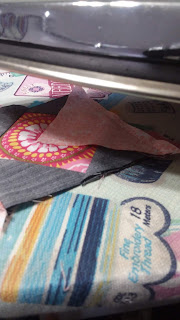Before beginning each block, I strongly suggest you read through the entire directions and look at the pictures to be sure you understand each step and to ensure that you cut correctly.
As always, remember your accuracy in cutting…
keeping the measuring line of your ruler ON the fabric.
**********************************
Today we will start this Section 2 with the Pershing Block.
I will warn you, this is, what I feel, the most difficult block so far. But, we will work through it step by step.
We start with the cutting found on page 6 of your booklet/pattern
Accuracy is important! Be sure to keep the lines of your ruler ON the fabric.
Using the same ruler will be helpful for consistency. Measurements can be different from ruler to ruler; brand to brand
(for anyone with a good eye... yes, those yellow triangles are disproportionately big... I discovered my error when it came time to add them to the block and corrected my mistake.)
We will start this block by making the center Square-in-a-square following the same steps used in Section 1.
Draw diagonal lines on your small squares.
Draw diagonal lines on your small squares.
Stitch a pair of squares to opposite corners of the center square, sewing next to your drawn line
Repeat with the other pair of squares.

One fun thing I like to do is use my Buddy Ruler by Bonnie Hunter. After stitching on each set of squares I use my Buddy Ruler to draw a second line. I stitch next to this second line closer to the previously sewn line. You can then cut between the two sewn lines and you have made a cute little HST to be used in another project... or sometimes as a unit in your current project.


Next, we surround our center square with triangles.
Fold the center square and finger press to form a line. Fold the triangle in half also. Align the two folds to center the triangle along the center line fold of the square pointing the tip down the the center of the square. Carefully stitch your scant 1/4inch being careful to sew just above the "X" formed by previous stitching.
Now we set the seam and press open.
Setting the seam means to just press down... no ironing or swishing back and forth, that can stretch the threads or fabric. You can see in the pictures below that it flattens your block. Straight down, straight up.
Repeat the same process with the opposite triangle. Then again, with the other two opposing triangles to surround the center square.
We repeat this same process again with the next round of triangles adding opposing sides.
This next round we will be adding a stripset of three triangles.
Flip the center triangle onto the left one.
Line up the edges but leave the dog ears overhanging
(yellow overhangs at the top, black overhangs at the bottom)
Stitch and gently press open.
Repeat with the left side triangle, line up the edges and leaving the dog ears overhanging.

Repeat this process for all four sides of the square.
Attaching these stripsets to the sides of the square is next. I put a pin straight through the points to match them up. Then pin on either side to hold the points together.
Stitch together being sure to stay just above that "X" formed by previous stitching
This part stumped me... I had to rip and stitch these multiple times in order to keep my points. I Cut off the yellow point, OR I didn't get close enough on the pink point. It is just very fussy with the two points coming together like this.
I finally decided that sewing it with the opposite side up seemed to work best. Why? I have no idea.
Normally, I am an advocate of pressing the seams in one direction or the other. But, with all that bulk where the points meet, I decided it was best to press these seams open.
Lastly, we need to add the remaining four triangles to complete this block. I finger pressed the triangle in half and lined that fold up with the center of the red triangle at the point (offset in the picture to show you location) Pin and stitch.
Stitch opposite side triangles on and press open to complete
I trimmed this block by lining up the 1/4in line on my square at those black points to save my 1/4in seam allowance and points when incorporating the block into the quilt.
BUT
I have to tell you... my square came out 1/4 too big....
I don't know why.
But, I am going to leave it as is. I am hoping that I will be able to ease it into the quilt. I'll show you that later.
You can leave comments and questions below. I will reply to your comments ASAP.
Thanks for following along. Click on "newer post" to see the next block.


























I have just had similar problems to those you have described. When it comes to sewing the 3-triangle strips, the amount of overhanging dog-eared seems to be crucial in getting the central point triangle with a 1/4 inch seam allowance. I found with the whole block that my seam allowances were too big so my points do not meet but at least they are not buried. In the end the block finished up the correct size! Who knows why? So I have decided that 'finished' is better than 'perfect', if I unpicked it I wouldn't know how to correct the errors.
ReplyDeleteWhen I stitch a quarter inch seam I end up with a 9 1/4 block and when I stitch with a scant quarter I end up with a 9 3/4 block - cannot seem to get a 9 1/2!
ReplyDelete